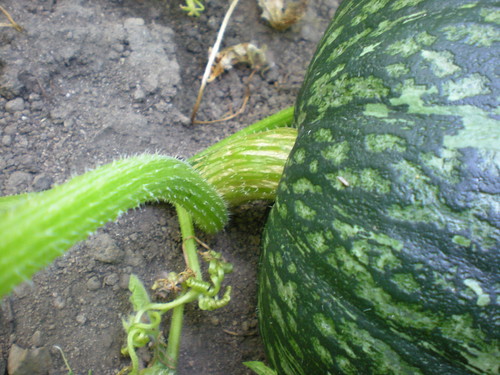On Sunday, when I was trying to determine if our first pumpkin is ready for picking, I saw this. I called Randy over, and he cried out "NOoooooo, powdery mideeeeeeew." (with hands next to his ears, waving back and forth). We have both been dreading this moment. This usually means the plants will stop producing new fruits then soon die, and PM might spread to other plants.
We immediately cut off and disposed affected leaves. On Monday, I sprayed diluted milk again (I just had to try). Then on Tuesday, I gave them a drink of liquid seaweed extract. Maybe I'll try Daphne's worm compost tea. I'm desperately trying to slow down PM. Good thing that the weather is warm this week. That should help, too.
As I mentioned, I was checking my pumpkins to see if they are ready for harvest. I had planned for this post to be about how to determine if they are ripe.
The Kitazawa website (where I got the seeds) says to "harvest when fruit reaches 6"-8" in diameter".
The UC Davis Postharvest Technology gives a good explanation of indicators of fruit maturity:
Maturity IndicesSo, how do you tell if the stem is "well corked"? This website has a few photos that show the progression of stem corking.
Corking of the stem and subtle changes in rind color (bright green to dull green in ‘Kabocha’ for example) are the main external indications of maturity. Immature fruit have a fleshy stem, maturing fruit will have some stem corking, and well mature fruit will have a well corked stem. Internal color should be intense and typical of the cultivar. The concentrations of the yellow and orange carotenoids generally increase only slightly during storage. Maturity at harvest is the major determinant of internal color. Immature fruit will be of inferior eating quality because they contain less stored carbohydrates. Immature fruit will have more decay and weight loss during storage than mature fruits.
Our biggest pumpkin is about 7.5" in diameter, and as you can see in the photo the stem is not "well corked" yet. I left the pumpkin on the plant. I just hope the plants can hang on and don't give in to PM!


No comments:
Post a Comment